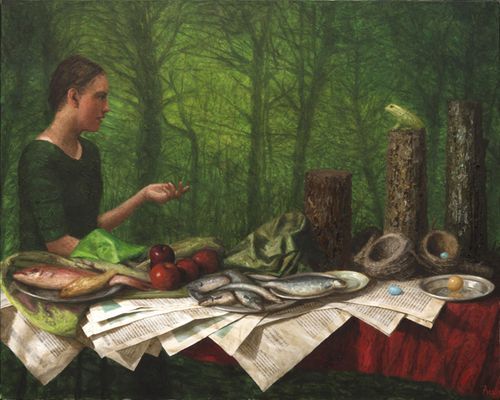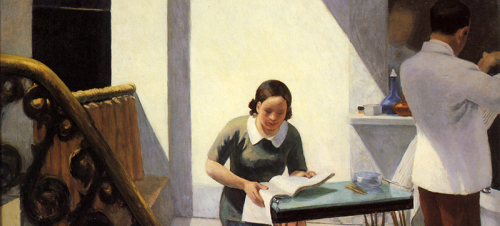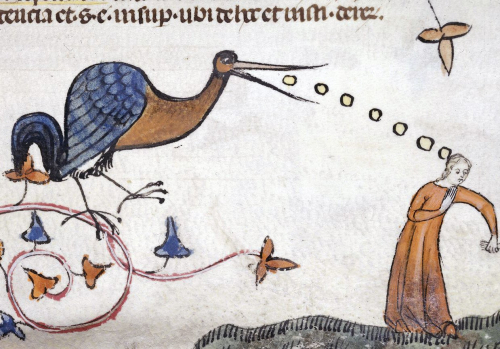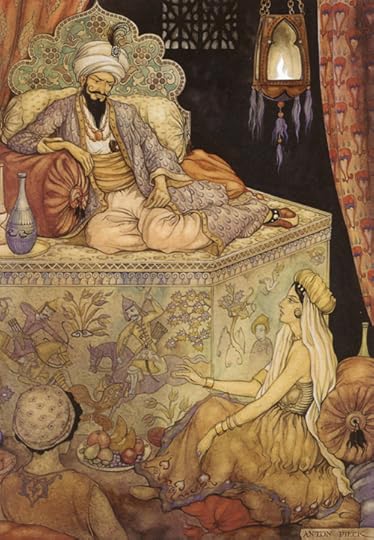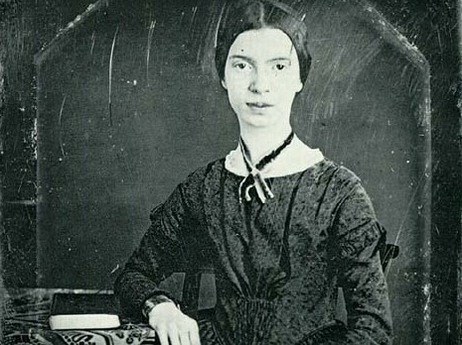Midori Snyder's Blog, page 18
August 8, 2018
Night Time Writing
Sometimes it's the best. Almost like dreaming and surprisingly effortless.
I think it's time, however, based on this lovely illustration by Italian artist Frank Matticchio, to update the alternate animal taxonomy taken from the ancient Chinese encyclop��dia entitled the Celestial Emporium of Benevolent Knowledge (and offered by Jorges Borges...which presents us with all kinds of intellectual dilemmas about its authenticity as a document or a charming piece of fiction.) Perhaps there should be a new listing for "Those who tell midnight tales."
��� Those that belong to the Emperor,
��� Embalmed ones,
��� Those that are trained,
��� Suckling pigs,
��� Mermaids,
��� fabulous ones,
��� Stray dogs,
��� Those included in the present classification,
��� Those that tremble as if they were mad,
��� The innumerable ones,
��� Those drawn with a very fine camelhair brush,
��� Others,
��� Those that have just broken a flower vase,
��� Those that from a long way off look like flies.
Or maybe this cheeky listing: "Those that love the camera"
I would also recommend stopping by to visit Laura Ottina's Animalarium blog -- which is filled with amazing animal illustrations and art from around the world.
August 6, 2018
Folklore and Three Generations of War
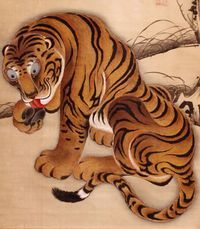 There is something so extraordinary about Tea Obreht's exquisite novel, The Tiger's Wife, set in what was once Yugoslavia over the course of WWI, WWII, and the recent wars that resulted in its dissection into new territories. War forms an continuous backdrop throughout the novel, often as a distant but deeply felt anxiety and sometimes exploding on the community. Boundaries shift with conflict and "our city," or "our fields" abruptly become someone else's property. Identities shift too as the long married wife whose origin, faith, or language suddenly mark her as an enemy to the new state.
There is something so extraordinary about Tea Obreht's exquisite novel, The Tiger's Wife, set in what was once Yugoslavia over the course of WWI, WWII, and the recent wars that resulted in its dissection into new territories. War forms an continuous backdrop throughout the novel, often as a distant but deeply felt anxiety and sometimes exploding on the community. Boundaries shift with conflict and "our city," or "our fields" abruptly become someone else's property. Identities shift too as the long married wife whose origin, faith, or language suddenly mark her as an enemy to the new state.
Against the constant threat of violence, the characters struggle to retain their humanity, their customs, and their hopes for a future. Some succeed -- though success here is measured more by how well one clings to a belief in human dignity and family. Some fail and become swallowed in fairy-tale fashion by the monsters of the day.
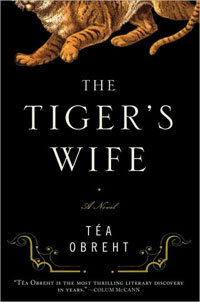 Nadia, the novel's protagonist, is a young pediatrician who sets out on a perilous journey, crossing newly minted borders to understand the reasons for her beloved grandfather's strange disappearance and death alone in a remote village. She also searches for the origin of the "tiger's wife," a story that has haunted her grandfather since childhood. In addition to Nadia's journey, the novel crisscrosses the country with multiple tales of other characters, weaving together a complex narrative of an ethnically diverse country.
Nadia, the novel's protagonist, is a young pediatrician who sets out on a perilous journey, crossing newly minted borders to understand the reasons for her beloved grandfather's strange disappearance and death alone in a remote village. She also searches for the origin of the "tiger's wife," a story that has haunted her grandfather since childhood. In addition to Nadia's journey, the novel crisscrosses the country with multiple tales of other characters, weaving together a complex narrative of an ethnically diverse country.
The novel also includes the use of local folktales and iconic figures -- especially the Deathless Man who reappears to the grandfather throughout the novel. And though the Deathless Man is a harbinger of death, he is oddly gentile, almost kind when compared to the random brutality of the wars. The tiger's wife, a terrified mute girl, is given strength by her unlikely friendship with a tiger who has become a refugee from a bombed out zoo. A band of poor villagers and their ailing children travel to a coastal vineyard to dig for the remains of compatriot, hastily stashed in a suitcase and buried during the last conflagration because they believe they can never be healthy until they properly honor their dead and bring him home.
 Obrecht's writing is elegant -- spare but filled with surprising beauty and precision when describing the landscape whether the mythic woods, decaying villages, or the eeriness of an elephant appearing on a city street during a night of bombing. But I would have to say that among the most powerful passages for me (and there are many here!) is this one, a reflection by the grandfather of the price of continuous war. It describes so many places in our world today and is the spine on which Nadia's and all the characters' stories are built:
Obrecht's writing is elegant -- spare but filled with surprising beauty and precision when describing the landscape whether the mythic woods, decaying villages, or the eeriness of an elephant appearing on a city street during a night of bombing. But I would have to say that among the most powerful passages for me (and there are many here!) is this one, a reflection by the grandfather of the price of continuous war. It describes so many places in our world today and is the spine on which Nadia's and all the characters' stories are built:
"But now, in the country's last hour it was clear to him, as it was to me, that the cease-fire had provided the delusion of normalcy, but never peace. When your fight has purpose -- to free you from something, to interfere on the behalf of an innocent--it has a hope of finality. When the fight is about unraveling -- when it is about your name, the places to which your blood is anchored, the attachment of your name to some landmark or event -- there is nothing but hate, and the long, slow progression of people who feed on it and are fed it, meticulously, by the ones who come before them. Then the fight is endless, and comes in waves and waves, but always retains its capacity to surprise those who hope against it."
For a more detailed review of this novel, I recommend Lisa Schillinger's "A Mythic Novel of the Balkan Wars" in the NYT Book Review.
To Hell with a Handbag.
Probably because my status has shifted from mother to um...crone (even though I don't have the long white braid wrapped around my head like a secret ninja whip -- wouldn't that be cool? )...I have been rediscovering with a new found pleasure all those story variants of the old woman who went to hell and then was sent back again after beating the imps sore, or returned on her own persistence after deciding she would remain for eternity wherever the hell she pleased. Often the women of these stories are harsh, old battle axes, though in the example of the indomitable Dowager of Downton Abbey, they do have all the best lines.
And this is why I love this little film, "Not Without My Handbag" -- creepy and wonderful -- where the crone is a fashionable Auntie determined to remain so, despite being summoned to hell for a late payment on her "Dante Wash and Spin" washing machine. This is an early film from the very talented studio of Aardman Animations and it's elegantly charming -- the Devil even speaks with a French accent.
I also like that the handbag has become one of those iconic accessories for the modern crone/grandmother. There's always a dollar or two, a hankie, a piece of candy, something to appease a beloved child regardless of age, and in some tales, the handbag is a bottomless source of magic (ala Mary Poppins.) My daughter watched this film as a child and discovered the cure for terror was the handbag -- of which she had many and as a child-crone in training, wielded it like a weapon if she felt threatened. And of course, there is Margaret Thatcher's infamous handbag which seemed to rule with a power of its own, causing her ministers to declare they had been "handbagged" when they felt sideswiped, and once before a meeting when Thatcher had set her bag down on the podium, but had left the room for a moment, a minister quipped "Why don���t we start? The handbag is here."
All this has got me thinking, I need to work on getting just the right handbag to keep me out of hell.
August 3, 2018
Katherine Ace: The Open Ended Metaphor
The structure of fairy tales and traditional folklore rests on the use of repetition to pattern the images into metaphors providing an emotional experience of transformation for the audience in the oral traditions as well as for the reader following them in print. Story tellers use repetition to shape the story and for emphasis on important details in each section of the tale. It begins with an interdiction at the home of birth, a repeated request to do or not to do something which usually by the third time is ignored. The middle section is a stripping away of identity and connection to the human world, the protagonist becoming lost in the woods, the veld, the sky, the sea. Swallowed up and sometimes ingested by the elements of nature and the fantastic.
Repetition helps to parallel the experience of the two separate moments: the repeated interdiction of "don't " becomes a new list in the middle of what must be done to survive. Feed the cat, oil the gate, clean the eyes of an old woman. But a price is paid, sometimes even a temporary death, as the old identity is stripped, and a new one is reformed in the fantastic world. And the last section, becomes the return home, often perilous, success dependent on how well nature has communicated the rules of survival and how well they are followed. If in accordance with nature, the protagonist returns, restored to a new identity, a new status, and new purpose.
Each section of the narrative -- separation, initiation, return-- is patterned in a parallel fashion to the other. As in metaphor, there is a delightful tension between where it begins, where it meets with the impossible, and where it sublates the changes to become something new and unique. The dialectical journey in rites of passage, the death of the old identity, the reforming and re-emergence of a new identity, are combined into a single metaphor of transformation, revealed through images from the human world, the fantastic world, and the cache of inherited cultural archetypes in the narrative performance.
All this is to explain, why I am so taken by the fairy tale art of Katherine Ace, who expresses her work with fairy tales in a very similar fashion -- painting the narrative with a series of visual metaphors folding in on themselves to express the unstable identities of the tales. She says this in her artist's statement:
"The intersection of contraries fascinates me: ecstasy and agony; humor and tragedy; natural and constructed realities; experience and news. I find that I'm curious about the struggles of diversity vs. unity in human, animal and plant societies. I am captivated by complex issues that we all face, and yet experience personally, intimately. I am interested in the role of dark feelings, thoughts and states of mind in the process of transformation, l am drawn to fire beneath reserve."
And again here when she considers the evocative imagery in fairy tales that fuels her ideas as an artist:
"I am interested in complex story telling using cultural myths and histories that reach back into our collective and personal pasts. Figures and still life figures evolve as open ended metaphors for concepts and environments that are themselves also metaphors, and therefore fold - like fabric, time, or paint - back in on themselves. Like a poem, a painting is a surface. The depth is in the surface (oddly). It sort of dawns on you - like the way one remembers a dream sometimes, in fragments that float up all through the day, assembling themselves oddly, disturbingly..."
I find this description compelling -- for it is in the story tellers performance, or the writer of fairy tales to create the same tension between the surface of the tale, and the dream-like, metaphorical journeys as real and fantastic collide in the stories, and that it is the experience itself -- dreamlike and disturbing that holds our fascination with the tales.
The paintings from top to bottom: "The Juniper Tree," "The Frog King," "The Handless Maiden," "Six Swans," and "Many Furs." (All my favorite tales!) For more information on Katherine Ace please visit her website.
August 2, 2018
People Inconvienced by Objects and Thoughts
I do love these wildly imaginative graphite portraits by Stefan Zsaitsits of People Inconvienced by Objects and Thoughts. They look almost exactly the way my head feels right after a day of juggling too many things and trying to get some writing squeezed in there somewhere. Though it does look as though, for today anyway, this may be the only writing I manage here.
August 1, 2018
What Has Blogging Become in the Age of a "Like Button" and Messaging in 280 Characters or Less?
I have been blogging at this location for the last ten years and it is with pleasure that I continue to so -- but perhaps with a much changed mission. When authors I know first started blogging, it was a way of communicating with people. I look back at the posts from five -six years ago, and I am surprised to see how many comments there are, sometimes a rich on-going discussion inspired by something in my post, or sometimes an exchange of very useful information. But such community is rare now on a blog. We have switched our allegiance to Facebook, where an announcement of a post does not actually mean someone will follow the link and read it, but they will express approval for the general idea by clicking the "like" button. And then we move even farther out, to a mere 280 characters in a tweet, to announce our blog post and receive a few "hearts" and maybe a re-tweet -- but still rare responses on the blog itself. Those kinds of conversations are pretty much over. And when I went down my list of bloggers, I was surprised to discover how many had packed it in for the nimble, quick-release variants of Facebook and twitter. And then there is Instagram, where the totality of an idea must be summed up in perfectly constructed images and hashtags.
Don't get me wrong -- I am not really complaining, just observing the transition and what it means for dinosaurs like me who still love to blog, even if it is for an audience of one. When I started blogging, I did so for the Journal of Mythic Arts and the Endicott Studio. We wanted to be a resource of myth, art, and folklore goodness. We wanted to share the wonderful work done by so many talented people. So the posts were always aimed outward. When we archived JoMA and the Endicott Studio, blogging finally shifted to the personal. I set up my own blog, In the Labyrinth in 2007 and wondered where it might take me.
What I discovered was a profound shift -- from promoting others to promoting myself and my work -- and it took a while to figure that out. How much personal information to share, family photos, events, favorite meals -- all the early posts that now seem so much better suited for Facebook. And somewhere along the way, I also wanted to review books I loved, write short critical essays on literary culture, folklore, my own writing, and what inspired me. I am pretty eclectic, I know that -- a magpie who is happy to post on the intellectual roots of Garcia Lorca's "Duende" to theatrical work with trance-inducing masks, to Medieval bad-boys who wrote pornographic poetry, deconstructing a brilliant sentence by Joseph Conrad, Balzac's treaties on Coffee drinking (which bordered on the hallucinogenic), Russian artists, Medieval Manuscripts and Irish poets, and The Voynich Manuscript. I do try and promote my work by sharing my research notes and excerpts, my struggles sometimes with getting a story right, and the ever important announcement of a completed new work.
I understand that I am writing a journal, and that actually pleases me. I am less concerned with how far a post of mine travels, but rather that I can call up the evolution of my ideas over time -- a long time -- and revisit past ideas. A body of my own thought. But...in the interest of not feeling quite so lonely, I go every day now to other people's blogs that I find interesting and I make a point of responding to the post, to asking questions, sharing my own thoughts on the subject where appropriate. And I am planning once a week to share (on facebook of course!) the best of the blog posts for the week that I found, and encourage you if interested to visit them and respond.
Art credits: The inestimable Edward Hopper.
July 25, 2018
"Where Do You Get The Ideas For Your Novels?" Asked and Answered
The Shaping of Story: Working Through Ideas
My notes on re-reading Harold Scheub's work on oral narrative structures, and performance. They have shaped the way I think of the fantastic in narrative and how it functions, and by extension how those "electric moments" when the real and the fantastic push against each to create a charged metaphorical experience in the performance (and perhaps in my context as writer, in the creation of the text.) Scheub's voluminous writings on Story and Performance continue to challenge my thinking and my writing every time I go back and re-read his work.
Notes from Harold Scheub's Story : a really clear and detailed understanding of how story in the oral traditions become a focal point for harmonizing the different, idiosyncratic experiences and histories of the members of an audience. These are performances, and the meanings of the tale, from didactic to metaphorical occur in the performance as a reaction to the images and the aesthetic patterning of the tale to create a surface narrative from conflict to resolution while meaning is generated in the layering of emotionally evocative and metaphorical imagery. Within the performance the audience has a personal encounter with what is both familiar in the narrative and what can be interpreted and reinterpreted throughout the listener's life. (c.f. the child who hears the story, the young woman engaged in puberty rights, the new mother, wife or co-wife, the older woman who is telling the story to audiences of mixed ages or just her peers.)
Story is a combination of image and emotions, narrative movement, of form or patterning, the layering of imagery that results in story. The images are pulled from the inherited cache of emotionally evocative images which are paired with contemporary, more realistic images and their interaction in the story create a flashpoint. It is not in the suspension of disbelief that enables meaning but in the moment of tension in the pairing ("electric opposition") of the contemporary realistic images with the fantastic, ancient images which contain the deepest dreams, hopes, fears, nightmares of a world experience.
The storyteller organizes the images and the narrative in a surface movement from conflict to resolution, while at the same time patterning the emotionally evocative images into tropes that allow the audience to discover the nature of the relationship and its significance and meaning. The principle objective of the fantastic imagery is a poetic reorganization of the real -- and by the contrast to provide a new layer of meaning in the real.
Fantastic images provide a world of connections, of transformations, of metaphorical relations between the real and marvelous, and because many are inherited from a shared historical past, they will also contain fragments of history, ancient traditions that are reconstituted in a new way for contemporary understanding. Supernatural villains & helpers become manifestations of the struggle occurring to the protagonist. The fantastic elements are not an end into themselves, but as a means to push the story towards the metaphorical. It becomes the engine of change bringing the audience out to where uncertainty exists and then back to the familiar. The power of the tale is not one that emerges with a glimmering metaphor -- the performance of tale itself is the experience of metaphor and that is its power.
Fantasy tales are a form of reasoning, a way of looking at events in the context of emotion.The combination of the fantasy and the real in the stories provides a new measure of the real world. The blending of the two, not just fantasy alone is important because without the mooring of the real world, the fantasy would be dull -- fantasy breaks our world into artificial pieces and as the storyteller combines the images of reality with the introduction of fantasy, reality finds itself within a fantastic context, forcing our thinking about those matters into new modes.
July 24, 2018
Love and Do What You Will...
St. Augustine of Hippo is remembered by many young Catholics for his plea to God during his wild youth, "Give me chastity and continence, but not quite yet." (Actually, I have many non-religious friends who are familiar with this particular quote, finding it very amusing, indeed.) Recently, a friend of mine sent me this second quote which struck me as particularly powerful for our time:
"See what we are insisting upon; that the deeds of men are only discerned by the root of love. For many things may be done that have a good appearance, and yet proceed not from the root of love���Once for all, then, a short precept is given you: Love, and do what you will: whether you hold your peace, through love hold your peace; whether you cry out, through love cry out; whether you correct, through love correct; whether you spare, through love do you spare: let the root of love be within, of this root can nothing spring but what is good." (7th Homily on John 1)
I find it so compelling because I am sure almost every one one of us could expand this precept to our own struggles, goals, and desires. Mine would be: "Love and do what you will, whether you create, through love create; whether you write, through love write."
July 23, 2018
Emily Dickinson: Poetry on the Back of a Coconut Cake
In addition to writing sublime poetry, Emily Dickinson was also an excellent cook and baker. She often baked sweets and cakes for her neighbors and the neighborhood children. But poetry was never far from her mind and she combined her cooking arts with her literary skills. On the back of her recipe for this coconut cake was penned this poem:"The Things that never can come back."
"The Things that never can come back, are several ���
Childhood ��� some forms of Hope ��� the Dead ���
Though Joys ��� like Men ��� may sometimes make a Journey ���
And still abide ���
We do not mourn for Traveler, or Sailor,
Their Routes are fair ���
But think enlarged of all that they will tell us
Returning here ���
"Here!" There are typic "Heres" ���
Foretold Locations ���
The Spirit does not stand ���
Himself ��� at whatsoever Fathom
His Native Land ���"
Nelly Lambert, a Dickinson scholar at Catholic University, discovered in Dickinson's letters her delight at cooking and how often she referenced it in her letters. Lambert shares her discovery in an article for NPR (which includes the recipe and cooking suggestions for the Coconut Cake and an image of her handwritten recipe):
Dickinson discussed baking in many of her letters ��� evincing both her trademark wit and a zest for life that belies the common image of her as a depressed figure. Note the animation in her letter to a friend about some burnt caramel rule: "I enclose Love's 'remainder biscuit,' somewhat scorched perhaps in baking, but 'Love's oven is warm.' Forgive the base proportions."
In my own life, I have experienced the poet-cook as my father Emile Snyder published numerous volumes of poetry and was well known among his family and friends as a committed gourmet cook. It is one of the things I miss most about his absence -- I have his poems, but oh how I would love to sit in his kitchen again and watch him prepare something extraordinary, steam rising from the pots with fragrant aromas, the crisp freshness of garlic, parsley, basil under the crush of his knife, the sizzle of olive oils, the hiss of the wine poured into a frying pan with shallots and the whoosh of flame stirred up to release the alcohol -- and me getting tipsy on all the vapors. More than ten years later I still have my father's hand written recipes, stained from laying too close to the cutting boards. And I am reminded of all that reading Dickinson's opening lines: "The Things that never can come back, are several ���/Childhood ��� some forms of Hope ���/the Dead ���"
For more reading, I recommend the article "Emily Dickinson and Cooking, from the Emily Dickinson Museum and "In Praise of the Cook" I wrote for the Journal of Mythic Arts on the mythic powers of the cook in fairy tales and folklore.
Midori Snyder's Blog
- Midori Snyder's profile
- 87 followers





